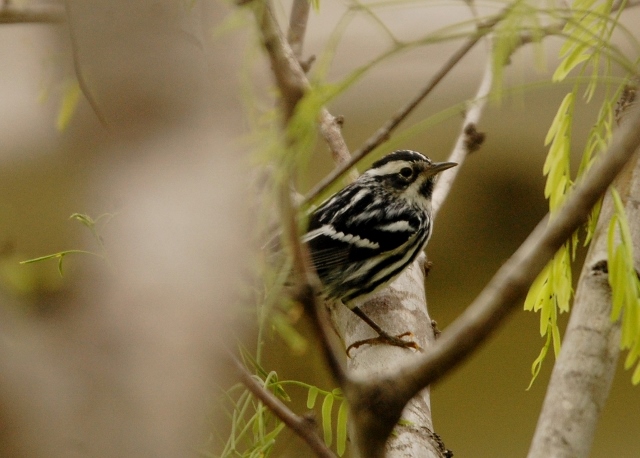by M. Kathy Raines

New to the rigors of warbler identification—an exasperatingly large number of these charmers being yellow, adorned with varying patterns of black—I thrill to spotting, and confidently IDing, the lovely and lively zebra-striped black-and-white warbler (Mniotilta varia).
This five-inch wood warbler, in the family Parulida—which includes small, primarily arboreal, insectivorous New World warblers—creeps headfirst down branches and trunks, its short legs and long back toe serving it well, plucking out insects and their larvae, which it grabs and thrashes against a trunk. It usually feeds at middle heights of trees, but one may spot the bird in the canopy or on the nearby ground.
This warbler sports bold, lengthwise black and white streaks from head to tail, the female’s plumage being grayer, with less contrast. It has a long, slightly-curved bill—useful for probing bark— a pointed head and a blunt tail.
Unlike many warblers, these birds do not startle easily, and, in fact, appear to be curious creatures, making them dandy subjects for novice photographers. Sitting next on the ground next to a tree at South Padre Island Convention Center last September, I was able to get some pretty good shots on my cellphone of one of these striped beauties creeping up and down the trunk.
The black and white warbler—partly by virtue of not being yellow—makes a pretty easy catch for novice warbler watchers and can be distinguished from the somewhat similar blackpoll, which has a black cap and cheeks, less noticeable stripes and no stripes on its head. Another warbler of similar appearance, the black-throated gray, has weaker streaks and a gray back.
This warbler is the sole member of its genus, Mniotilta, whose Greek origins mean “to pluck seaweed”—its discoverer mistranslated mnion, “seaweed”, as “moss”—alluding to the bird’s foraging of often moss-covered bark. Its Latin species name, varia, or “varied”, refers to its two-toned stripes.
Male black-and-whites have two major types of songs: during the day, their call, which is accented at the end, appears to solicit females. And when males lose their mates, they sing these more frequently. At dawn, they sing an unaccented, more complex song to other males, presumably defining their territory.
The male black-and-white gives a high, piercing, repetitive three-second call, which is longer, faster and more varied during breeding. Males’ songs soften when females are nearby. Both sexes give a chit call, with females calling mates, and males reciprocating.
Black-and-white warblers nest as far north as northern Canada, southward to the Gulf states, including the East Texas woodlands and sometimes the Houston area or the Edwards Plateau, and they winter along the Gulf—sometimes remaining in the Rio Grande Valley—southward to northern South America.
Black-and-whites are some of the earliest arrivals during both fall and spring migration; since they forage on bark, they need not await the spring sprouting of green leaves.
These warblers nest on the ground, concealing their lined bowls of bark, grasses and leaves beneath shrub branches or under fallen leaves. After about ten days, four or five brown-spotted eggs hatch. Both parents feed the hatchlings, which fledge in from eight to twelve days.
Black-and-white warblers, while not endangered, have declined in number. Cowbirds, as is their wont, do lay eggs in these warblers’ nests, which the unwitting hosts then nurture, to the detriment of their own nestlings. Also, they suffer from the fragmentation of their forests, especially their wintering grounds in the tropics. The longest living black-and-white warbler was eleven.

